This post may contain affiliate links. Please read our disclosure policy.
Fermenting tea leaves (lahpet) at home can be a rewarding culinary experiment, though it does require time, patience, and attention to detail. In this post, I’m sharing a simplified version of the traditional fermentation process.
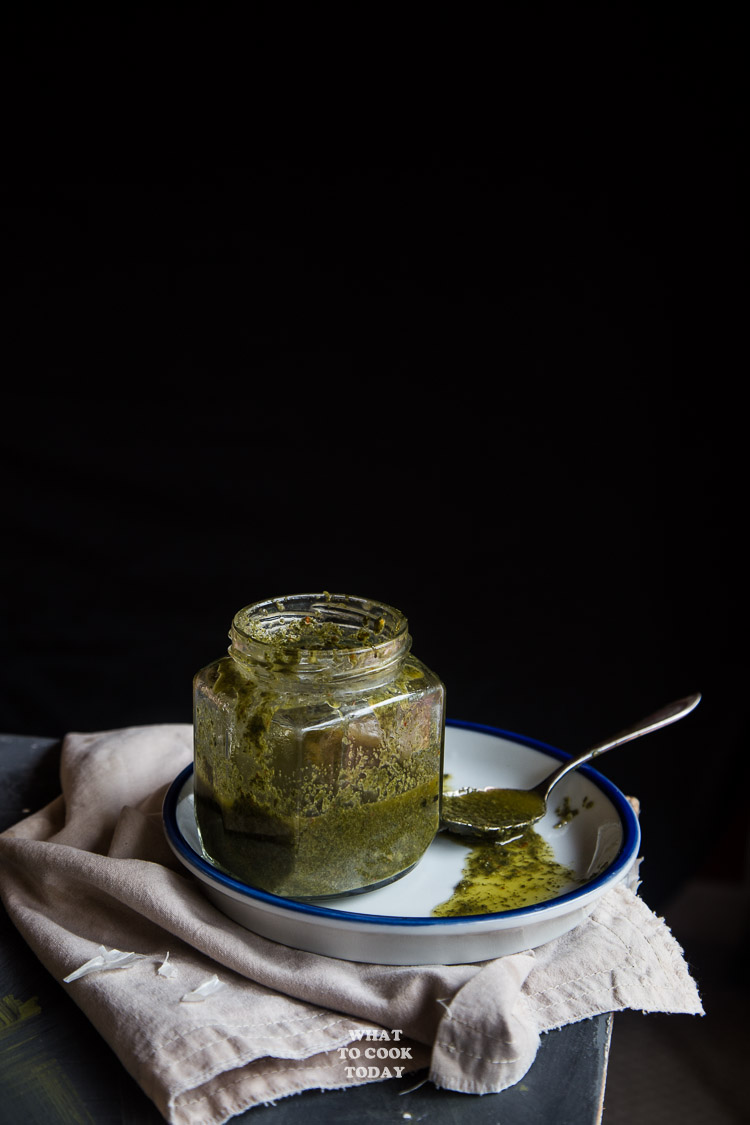
What is lahpet?
The primary ingredient, tea leaves, are handpicked from tea plants that thrive in the hilly regions of Myanmar. These tender, young leaves are meticulously plucked, steamed, and then left to ferment. The fermentation process is crucial, as it not only enhances the flavor but also preserves the leaves for an extended period. The resulting leaves are a medley of earthy, tangy, and slightly bitter notes.
Easy version of lahpet
My friend told me traditionally Lahpet takes a long time to make. Months! But it can be “faked” at home. So, this lahpet is made with adaptation from Burma Superstar cookbook (affiliate link) and tips from my friend and a reader who has shared how she made her lahpet. The lahpet is fermented for one week at room temperature before storing it in the fridge.
Homemade Lahpet (Burmese Pickled Tea Leaves)
Ingredients
- 4 Tbsp good quality dried green tea leaves
- hot water
- ⅔ cup cooking oil
Spices and herbs:
- 8 cloves garlic
- 1 cup fresh cilantro leaves
- 1 tsp dried chili flakes
- 2 Tbsp lime juice or other acid like vinegar or lemon juice
- 1 thumb-size ginger
Seasonings:
- ½ tsp fine sea salt or more to your taste
Instructions
Sterilize a glass jar by boiling or in the oven:
- To boil in water: boil the glass jar in boiling water for 15 minutes and then let it sit in the hot water when preparing other things
- To use oven: Preheat oven to 275 F (135 C). Place the glass jar on a baking tray and put inside the oven for 15 minutes and when it's done "baking", turn off the oven but leave the jar in there until you are ready to use it
- Place the tea leaves in a tea pot or a large heat-proof cup. Pour hot water over it and let it steep for about 3 minutes. Drain off the tea liquid and squeeze any excess liquid from the tea by pressing with the back of the spoon. I taste the tea leaves to see if it's too bitter or not. If you think it's too bitter to your taste, pour more boiling water on the tea again and let it steep for another 3 minutes and then squeeze out liquid from tea
- Transfer the tea leaves to a food processor, add the spices, herbs, seasonings, and oil. Process into a fine consistency
Fermentation:
- Use a tong to get the sterilized glass jar out from the water onto a clean kitchen towel to dry the outside and get as much water out as possible. If you clean the jar in the oven, just use a tong to get it out of the oven and it's ready to be used
- Transfer the mixture into the sterilized jar using clean utensils. I cover it with a clean coffee filter secure with a rubber band and let it sit at a warm place around 82-90 F to ferment for 7-10 days. I did 7 days
- After 7 day, secure the lid on the jar and place this in the refrigerator. It can be kept in the fridge for about a 2-3 weeks or so or keep in the freezer for 3-6 months
- The laphet dressing is ready to be used for laphet thoke
How to make an easy version of lahpet
1. Sterilize a glass jar. To boil in water: boil the glass jar in boiling water for 15 minutes and then let it sit in the hot water when preparing other things. To use oven: Preheat oven to 275 F (135 C). Place the glass jar on a baking tray and put inside the oven for 15 minutes and when it’s done “baking”, turn off the oven but leave the jar in there until you are ready to use it
2. Place the tea leaves in a tea pot or a large heat-proof cup. 
2. Pour hot water over it and let it steep for about 3 minutes. Drain off the tea liquid and squeeze any excess liquid from the tea by pressing with the back of the spoon. I taste the tea leaves to see if it’s too bitter or not. If you think it’s too bitter to your taste, pour more boiling water on the tea again and let it steep for another 3 minutes and then squeeze out liquid from tea
3. Transfer the tea leaves to a food processor, and add the spices, herbs, seasonings, and oil. 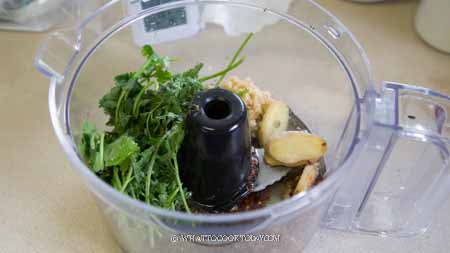
4. Process into a fine consistency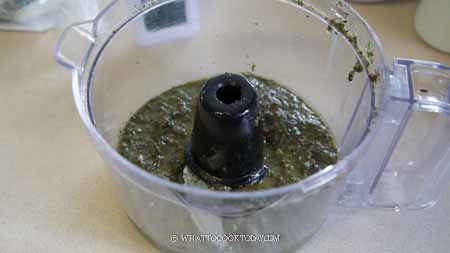
5. Transfer the mixture into the sterilized jar using clean utensils.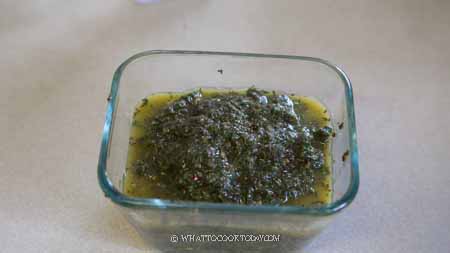
6. I cover it with a clean coffee filter secure with a rubber band and let it sit at a warm place around 82-90 F to ferment for 7-10 days. I did 7 days. I checked on it every day by observing and smelling to make sure no mold or other unwanted things grow in there. Since it is soaked in vinegar and oil, and the jar is sterilized, it is safe to say that the lahpet was quite “protected”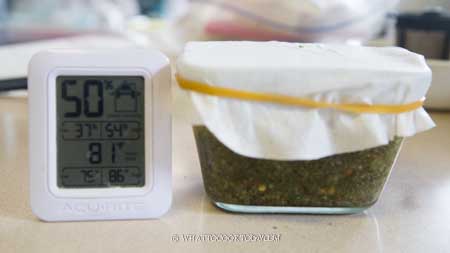
7. After 7 day, secure the lid on the jar and place this in the refrigerator. It can be kept in the fridge for about a 2-3 weeks or so or keep in the freezer for 3-6 months

Lahpet thoke is enjoyed for its complex taste, combining the sourness of the fermented tea leaves, the crunchiness of the vegetables, the nuttiness of the peanuts, and the spiciness of the chili peppers. It’s a prime example of the diversity and uniqueness of Burmese cuisine.
Did you make this easy lahpet recipe?
I love it when you guys snap a photo and tag it to show me what you’ve made. Simply tag me @WhatToCookToday #WhatToCookToday on Instagram and I’ll be sure to stop by and take a peek for real!

Don’t forget to check out How to make Lahpet Thoke (Burmese fermented tea leaves salad)
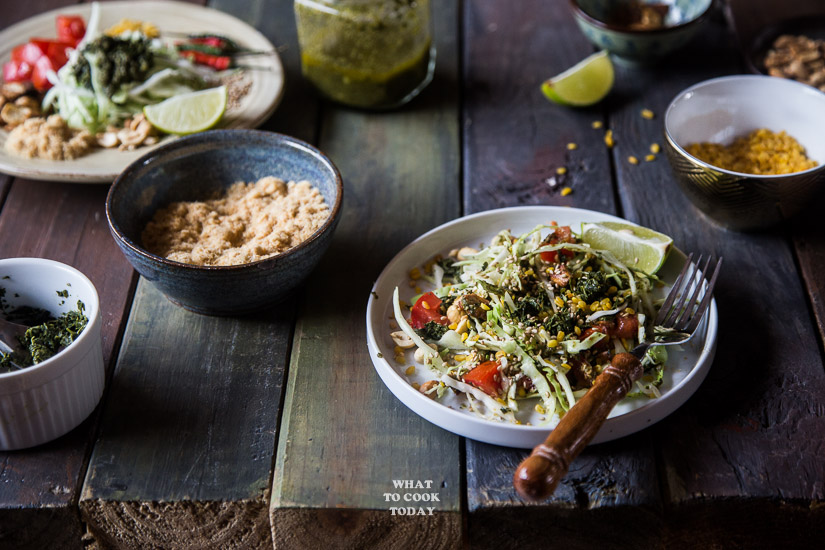

36 comments
just came back from Myanmar and i was so sad that I didn’t buy any fermented tea leave to bring back to make salad. then i stumbled on to your website and found a receipt. Thank you so much for sharing!
I love Myanmar Food:)
Hi Theresa,
This is more of “cheat” version, but I still love it just as much! I’ve never tasted the real thing before. But it’s on my list if I ever visited Myanmar!
I love pickled tea leaves. I haven’t tried making this at home; but as I stay in India-Myanmar border, I can buy it easily there in Myanmar Market.
Lucky you 🙂
Thank you, Marvellina! I appreciate your help and the inspiration – I will experiment.
I would love to make laphet from fresh leaves from my tea plants. Do you have any hints for this? (Should I still dry/process them or can I use them fresh?) I also wonder which leaves are used, since different teas are composed of just the growing tip or + 1 to 2 leaves. Do they use older leaves for this or stick to the tips and young leaves? Thank you for this recipe!
Hi Raven,
I’m not an expert with Lahpet, but from what I have read before, traditionally Laphet was made from fresh tea leaves (usually the fresh young leaves) and then fermented. The fresh leaves (collection of two leaves and the bud) are usually steamed briefly about 5 minutes or so and then water is squeezed out as much as possible and then proceed to fermentation. The natural process takes months, but this recipe is not a “real” fermentation, but you can proceed with the recipe after steaming the leaves. I made my lahpet using green tea, but I’ve seen people made it with black tea leaves too. Hope this helps!
Hi Marveling, thanks for the info. The lemon grass condiment appeared to be the majority ingredient w/ other unnamed savory bits. Tasty and I guess you could have doctored it up w/ any of the other seasonings on the table. I think a repeat visit is in order.